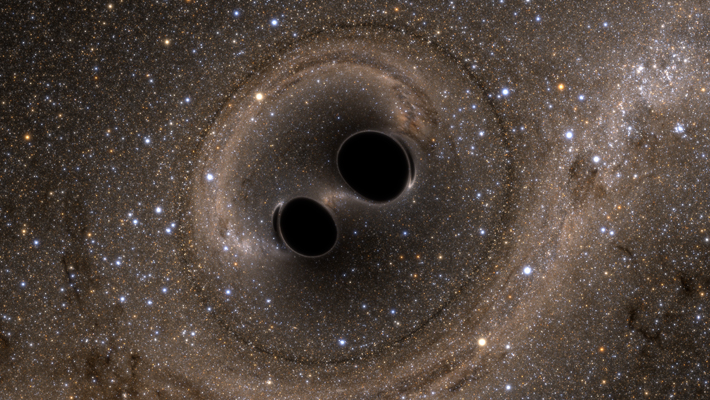Using gravitational waves to catch runaway black holes
Two CTC researchers, Davide Gerosa and Christopher Moore, have developed a new method for detecting and measuring one of the most powerful, and most mysterious, events in the Universe – a black hole being kicked out of its host galaxy and into intergalactic space at speeds as high as 5000 kilometres per second.
The method could be used to detect and measure so-called black hole superkicks, which occur when two spinning supermassive black holes collide into each other, and the recoil of the collision is so strong that the remnant of the black hole merger is bounced out of its host galaxy entirely. Their results are reported in the journal Physical Review Letters.
Earlier this year, the LIGO Collaboration announced the first detection of gravitational waves – ripples in the fabric of spacetime – coming from the collision of two black holes, confirming a major prediction of Einstein’s general theory of relativity and marking the beginning of a new era in astronomy. As the sensitivity of the LIGO detectors is improved, even more gravitational waves are expected to be detected – the second successful detection was announced in June.
As two black holes circle each other, they emit gravitational waves in a highly asymmetric way, which leads to a net emission of momentum in some preferential direction. When the black holes finally do collide, conservation of momentum imparts a recoil, or kick, much like when a gun is fired. When the two black holes are not spinning, the speed of the recoil is around 170 kilometres per second. But when the black holes are rapidly spinning in certain orientations, the speed of the recoil can be as high as 5000 kilometres per second, easily exceeding the escape velocity of even the most massive galaxies, sending the black hole remnant resulting from the merger into intergalactic space.
The Cambridge researchers have developed a new method for detecting these kicks based on the gravitational wave signal alone, by using the Doppler Effect. The Doppler Effect is the reason that the sound of a passing car seems to lower in pitch as it gets further away. It is also widely used in astronomy: electromagnetic radiation coming from objects which are moving away from the Earth is shifted towards the red end of the spectrum, while radiation coming from objects moving closer to the Earth is shifted towards the blue end of the spectrum. Similarly, when a black hole kick has sufficient momentum, the gravitational waves it emits will be red-shifted if it is directed away from the Earth, while they will be blue-shifted if it’s directed towards the Earth.
“If we can detect a Doppler shift in a gravitational wave from the merger of two black holes, what we’re detecting is a black hole kick,” said study co-author Davide Gerosa. “And detecting a black hole kick would mean a direct observation that gravitational waves are carrying not just energy, but linear momentum as well.”
Detecting this elusive effect requires gravitational-wave experiments capable of observing black hole mergers with very high precision. A black hole kick cannot be directly detected using current land-based gravitational wave detectors, such as those at LIGO. However, according to the researchers, the new space-based gravitational wave detector known as eLISA, funded by the European Space Agency (ESA) and due for launch in 2034, will be powerful enough to detect several of these runaway black holes. In 2015, ESA launched the LISA Pathfinder, which is successfully testing several technologies which could be used to measure gravitational waves from space.
The researchers found that the eLISA detector will be particularly well-suited to detecting black hole kicks: it will be capable of measuring kicks as small as 500 kilometres per second, as well as the much faster superkicks. Kick measurements will tell us more about the properties of black hole spins, and also provide a direct way of measuring the momentum carried by gravitational waves, which may lead to new opportunities for testing general relativity.
“When the detection of gravitational waves was announced, a new era in astronomy began, since we can now actually observe two merging black holes,” said Christopher Moore, who was also a member of the team which announced the detection of gravitational waves earlier this year. “We now have two ways of detecting black holes, instead of just one – it’s amazing that just a few months ago, we couldn’t say that. And with the future launch of new space-based gravitational wave detectors, we’ll be able to look at gravitational waves on a galactic, rather than a stellar, scale.”
This is a slightly altered version of an article which first appeared on the website of the University of Cambridge: http://www.cam.ac.uk/research/news/using-gravitational-waves-to-catch-runaway-black-holes

Image credit: SXS Lensing
